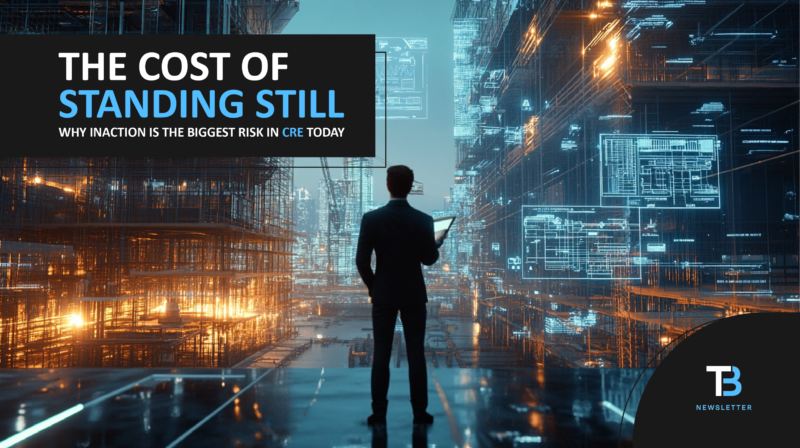Standing Still Is Falling Behind
In a commercial real estate landscape where innovation moves fast and tenant expectations move faster, inaction is no longer a neutral choice—it’s a costly one.
Too often, developers, architects, and property owners fall into a false sense of security by sticking with the status quo. But in CRE, “doing nothing” carries real-world consequences—ones that affect your bottom line, tenant retention, project timelines, and long-term asset value.
The truth is: not making a decision about technology is a decision. And one that often leads to higher costs, missed opportunities, and diminished competitiveness.
In this post, we’ll explore the real risks of inaction, backed by real-world examples, and share a roadmap to help you move forward strategically and confidently.
Real Cost #1: Higher Total Project Spend
It’s common to delay tech decisions in the hope of “saving money.” Ironically, this almost always leads to more expensive outcomes.
Example:
A mid-sized office project postponed their smart building technology plan until after construction began. When the decision was finally made, systems had to be retrofitted. This led to:
- Costly rework on infrastructure
- Delays in mechanical and electrical timelines
- Budget overruns due to change orders
Had tech strategy been part of the design phase, the project could have saved significantly in labor, hardware, and coordination costs.
Why It Happens:
- Lack of early tech alignment
- Underestimating integration complexity
- “We’ll deal with that later” mindset
Real Cost #2: Missed Opportunities for Innovation
When decisions are delayed, teams tend to default to known, legacy solutions instead of exploring emerging, more effective technologies.
Example:
A luxury mixed-use developer skipped a vendor-neutral design review and opted for a bundled “smart” solution from their general contractor. The result?
- A clunky tenant app with low adoption
- Energy systems that couldn’t scale
- A 3-year technology lifespan instead of 10+
Innovative alternatives existed—but were never explored.
What You Miss Without a Broader View:
🚫 Integration with future tech
🚫 Competitive differentiation
🚫 Customization aligned to user needs
Real Cost #3: Poor User Experience and Lower Tenant Retention
Your end-users—tenants, guests, operators—interact with your building daily. Technology that frustrates or confuses them directly affects satisfaction and lease renewals.
Example:
An office tower introduced an access control system without consulting tenants or building staff. Within weeks:
- Users complained about inconsistent app performance
- Front desk staff reverted to manual check-ins
- Building security vulnerabilities emerged
The tenant experience suffered. By the time the system was re-evaluated, a major anchor tenant had chosen not to renew.
Why UX Matters in CRE:
- Great design enhances daily life
- Bad design drives tenants away
- People talk—and reputation matters
Real Cost #4: Delays That Derail Projects
In CRE, time is money. Delays in technology planning can impact everything downstream—schedules, budgets, and trust.
Example:
A high-profile developer greenlit tech planning six months after architectural drawings were finalized. The result:
- Structural adjustments required for smart infrastructure
- Conflicting specs between disciplines
- General contractor delays and liquidated damages
The launch date slipped by nine months—and leasing momentum suffered.
Real Cost #5: Loss of Competitive Edge
Smart building features are no longer a “nice-to-have”—they’re a tenant expectation. When you delay or ignore strategic tech integration, you lose your edge.
Example:
Two class-A office buildings launched within a month of each other in the same city. One offered:
- Touchless access
- Real-time environmental controls
- High-performance WiFi
The other? A polished aesthetic, but little else.
By year’s end, the first building had 80% occupancy. The second hovered at 40%.
Real Cost #6: Falling Behind the Future
Technology in CRE is evolving rapidly—AI, digital twins, IoT, smart metering, and ESG integrations are redefining building performance. Waiting too long means playing permanent catch-up.
What Future-Ready Looks Like:
✅ Flexible infrastructure
✅ Open systems that adapt
✅ Buildings that learn and evolve over time
Without intentional planning today, you’ll be:
- Stuck in a costly upgrade loop
- Missing out on energy savings and incentives
- Reacting instead of leading
“Smart buildings aren’t just defined by what they can do today—they’re shaped by how well they adapt to tomorrow. The real risk isn’t doing too much—it’s doing nothing at all.”
— Ken Wilkinson, CEO, Layer 10
What to Do Instead: A Smarter Path Forward
You don’t need to rush—but you can’t afford to stand still.
Here’s how to move forward strategically:
✅ Involve Technology Experts Early
• Technology strategy should start in pre-design, not post-construction.
• Experts ensure alignment between vision, systems, and scalability.
✅ Adopt a Vendor-Neutral Approach
• Don’t settle for default solutions.
• Evaluate multiple paths to find what best suits your goals.
✅ Focus on Integration & Adaptability
• Systems should work together, not in silos.
• Infrastructure should support evolution—not replacement.
✅ Prioritize Human-Centered Design
• Ask: How will people use this space every day?
• Design for experiences, not just operations.
Learn How to Avoid These Risks at Layer 10 Academy
We’ve helped CRE professionals across the country move from paralysis to progress—without sacrificing smart design or strategy.
At Layer 10 Academy, you’ll learn how to:
📌 Align technology planning with design timelines
📌 Identify risk factors before they derail your project
📌 Create scalable, human-centric solutions
📌 Avoid the financial traps of deferred action
🔗 → Start building smarter today: Explore Layer 10 Academy
Final Thought: The Cost of Inaction Is a Line Item You Can’t See—Until It’s Too Late
If you’re waiting for the perfect moment, perfect product, or perfect plan—you might be missing your window.
Smart, flexible, forward-thinking action today will pay off far more than reactive moves tomorrow.
Let’s build tomorrow, today.

The development of automated security orchestration and response tools has been a breakthrough for incident response teams. Watching how these systems can detect, analyze, and respond to threats in real-time is impressive. It’s helping security teams stay ahead of increasingly sophisticated attacks.